Polidoro da Caravaggio
Polidoro Caldara, usually known as Polidoro da Caravaggio (c. 1499 – 1543) was an Italian painter of the Mannerist period, "arguably the most gifted and certainly the least conventional of Raphael's pupils",[1] who was best known for his now-vanished paintings on the facades of Roman houses. He was unrelated to the later painter Michelangelo Merisi da Caravaggio, usually known just as Caravaggio, but both came from the town of Caravaggio, and the fact that Polidoro had a high reputation may have led Michelangelo Merisi to take the by then rather unusual step of adding the name of his home town to his own name.
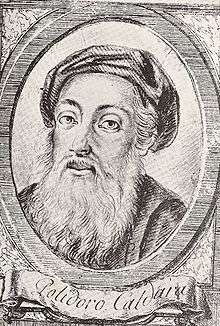
Life and work
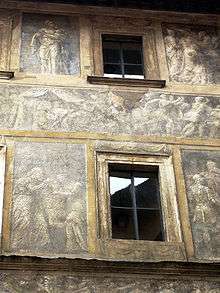
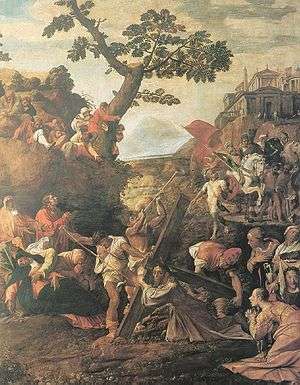
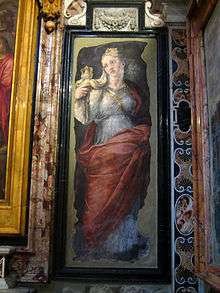
Polidoro Caldara was born in Caravaggio, in what is now Lombardy. According to Vasari, whilst working as a labourer carrying the materials for the builders of the Vatican logge he ingratiated himself with the artists, and attracted the admiration of Maturino da Firenze, one of Raphael's main assistants in the ongoing decoration of the Vatican. He then joined Raphael's large workshop, in about 1517, and worked on the Raphael Rooms in the Vatican. He and Maturino then set up as painters of palace facades, usually in sgraffito, with considerable success until the sack of Rome by the army of Charles V under the command of Constable de Bourbon in 1527, in which Maturino was killed. Polidoro fled to Naples, and from there to Messina, where he was very successful. According to tradition, he was about to return from there to the mainland of Italy when he was robbed and murdered by an assistant, Tonno Calabrese, in 1543.
In the second half of the sixteenth century his tomb in Messina (inside Carmine Maggiore, with the tomb of Constantine Lascaris) was totally destroyed during the repression of the Counter-Reformation.[2]
Polidoro's main paintings include a Crucifixion, painted in Messina, and a Deposition of Christ (1527) and a Christ Carrying the Cross (1530–34) both in the Museo di Capodimonte of Naples, who have the best collection of his work[3] (an oil sketch for the latter is in the National Gallery, London).[4] They are very individual in style, extremely free in technique, and powerful in expression. The Christ bearing the Cross shows considerable Northern influence, probably reflecting the traditionally strong links between Sicily and the Netherlands.
His other works, as well as those of his partner, Maturino da Firenze, have mostly perished from exposure, as most were external decorations on the facades of palaces, but are known from many etchings by Pietro Santi Bartoli, Cherubino Alberti and others. One of his pupils is Deodato Guinaccia. They were authors of the facade decoration in classicising Graffito, usually in grisaille, of several Roman houses, like those ones in Borgo and in Parione (near Santa Maria della Pace and in Via del Pellegrino).[5] A series of nine small internal wood panels from an unknown palace, perhaps in Naples, of which eight are now in the English Royal Collection, and one in the Louvre, give an idea of the liveliness and quality of these lost works: "Polidoro learned from Raphael the idea of re-creating the decoration of classical antiquity; but he did so with a wit, freedom and spirit of his own".[6] Being always visible to the public, whilst they lasted the palace facades were very well known and influential, and used by "generations of young artists ... as a visual textbook".[7] There are also many surviving drawings of high quality.[8]
Assassination
According to Vasari, Polidoro was firmly resolved to return to Rome after completing significant projects in Messina. In order to make preparations for this trip, he withdrew all of his savings from the bank for the trip to Rome. Upon discovering this, one of Polidoro's workmen, along with several accomplices, resolved to put the master to death on the following night, and then to divide the money among themselves. On the night following, they set upon Polidoro while he was slumbering deeply, and strangled him with a cloth. Then, giving him several wounds, they made sure of his death; After a period of many days when no perpetrator was discovered, it was thought that no one except the workman could have committed the act. Upon receiving intelligence of the assistant's alleged involvement, he was captured on the authority of the Count of Messina, and tortured until he confessed to the crime. Shortly thereafter, he was sentenced to the gallows, torn with red-hot pincers, and quartered[9]
Legacy
Among Polidoro's pupils in Messina was Deodato Guinaccia, Stefano Giordano, Mariano Riccio, Antonello Riccio, Jacopo Vignerio, and Alfonso Lazzaro.[10]
Gallery
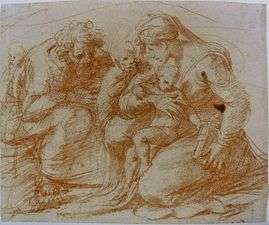 Red chalk drawing of the Holy Family.
Red chalk drawing of the Holy Family.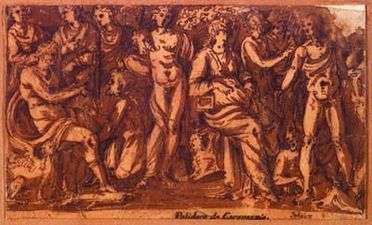 Assembly of Gods Lavis by Polidoro da Caravaggio, c. 1524. Probably study for the decoration of the Rota palace in Naples.
Assembly of Gods Lavis by Polidoro da Caravaggio, c. 1524. Probably study for the decoration of the Rota palace in Naples.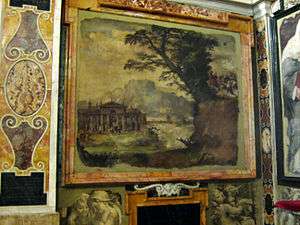 Landscape by Polidoro da Caravaggio and Maturino da Firenze, in S. Silvestro al Quirinale, Rome (c. 1525)
Landscape by Polidoro da Caravaggio and Maturino da Firenze, in S. Silvestro al Quirinale, Rome (c. 1525)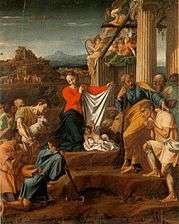 Adoration of the Shepherds, Messina
Adoration of the Shepherds, Messina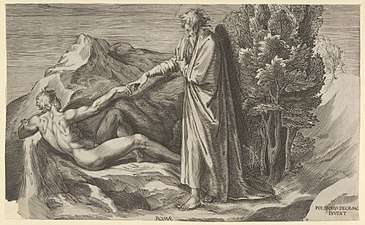 The Creation of Adam who reclines at left and touching the hand of God, Metropolitan Museum of Art
The Creation of Adam who reclines at left and touching the hand of God, Metropolitan Museum of Art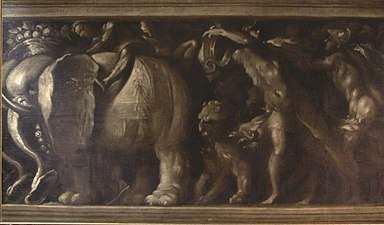 Military procession, MET
Military procession, MET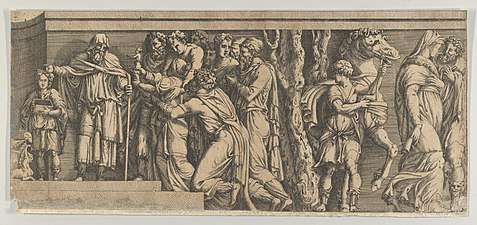 Statue of Niobe and her Worshippers, with Apollo and Diana and other Figures, MET
Statue of Niobe and her Worshippers, with Apollo and Diana and other Figures, MET
Notes
- National Gallery, London Archived 2007-06-22 at the Wayback Machine
- Russo, Attilio (2003-2004). Costantino Lascaris tra fama e oblio nel Cinquecento messinese, in "Archivio Storico Messinese", 84-85, Messina 2003-2004, pp. 5-87, especially 22-28 and 42-44, ISSN 0392-0240
- Nicola Spinosa (ed), The National Museum of Capodimonte, Electa Napoli, 2003, ISBN 88-510-0007-7 image
- Nationalgallery.org.uk Archived 2007-03-03 at the Wayback Machine
- Museodiroma.it
- "Items 6-12". Archived from the original on 2007-09-27. Retrieved 2007-05-10.
- Lucy Whitaker, Martin Clayton, The Art of Italy in the Royal Collection; Renaissance and Baroque,pp 56, 63, Royal Collection Publications, 2007, ISBN 978-1-902163-29-1
- "Royalcollection.org.uk". Archived from the original on 2007-09-27. Retrieved 2007-05-10.
- Giorgio Vasari. Lives of the Most Eminent Painters Sculptors and Architects, Vol. 05 ( of 10) Andrea da Fiesole to Lorenzo Lotto. Project Gutenberg.
- Guida del Viagiatore in Sicilia., by Salvatore Lanza, Presso I Fratelli Pedone Lauriel, Palermo (1859), page LXII.
References
- Polidoro (da Caravaggio) Caldara - Catholic Encyclopedia article
External links
| Wikimedia Commons has media related to Polidoro da Caravaggio. |
- Artcyclopedia
- Vasari's Life (in English)